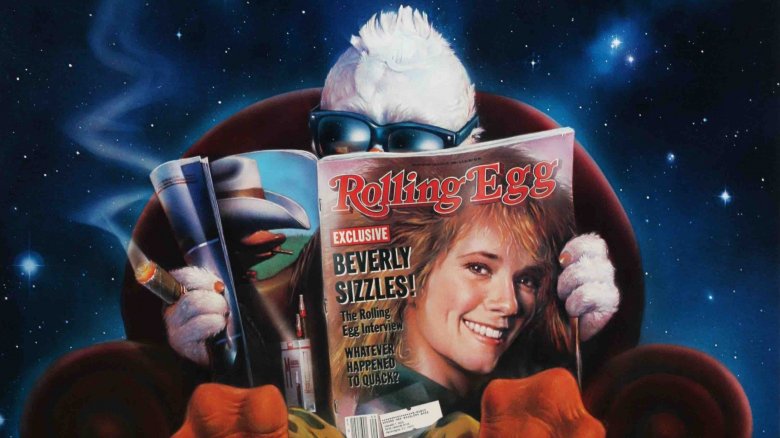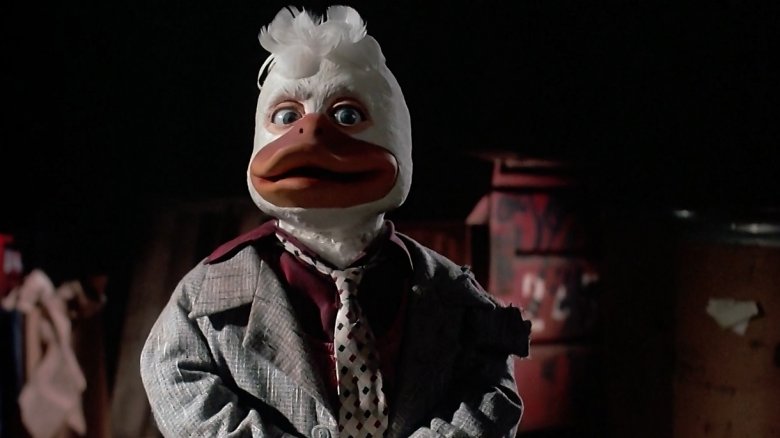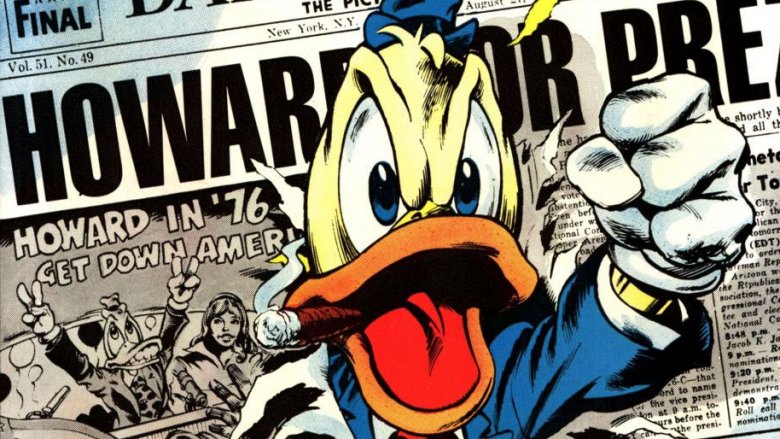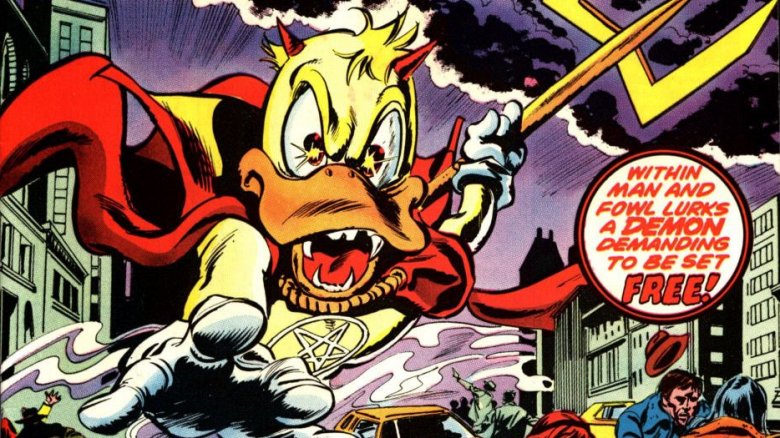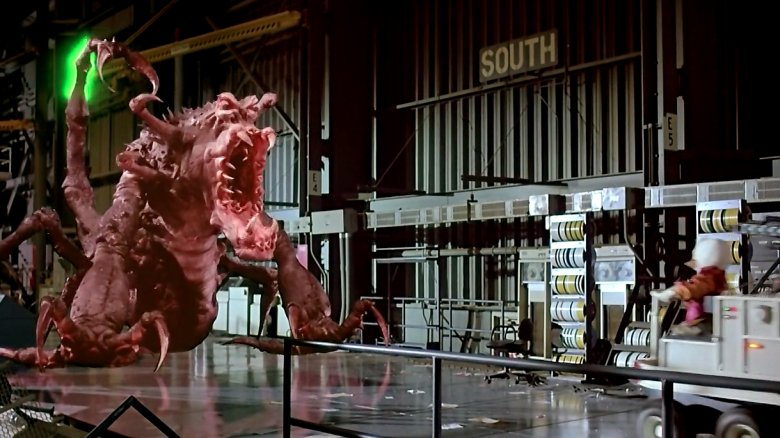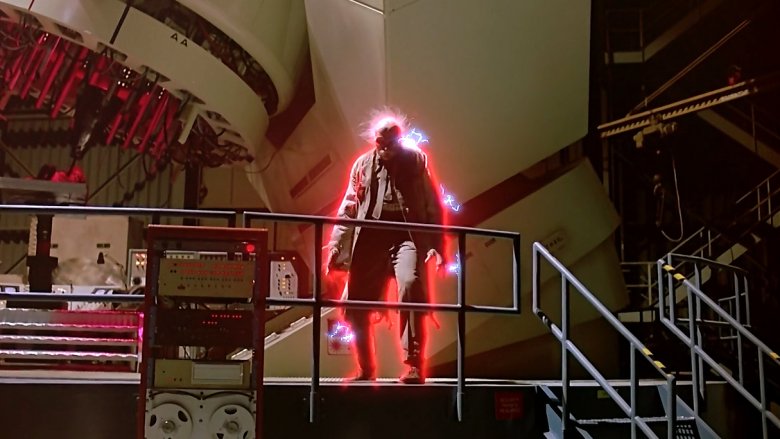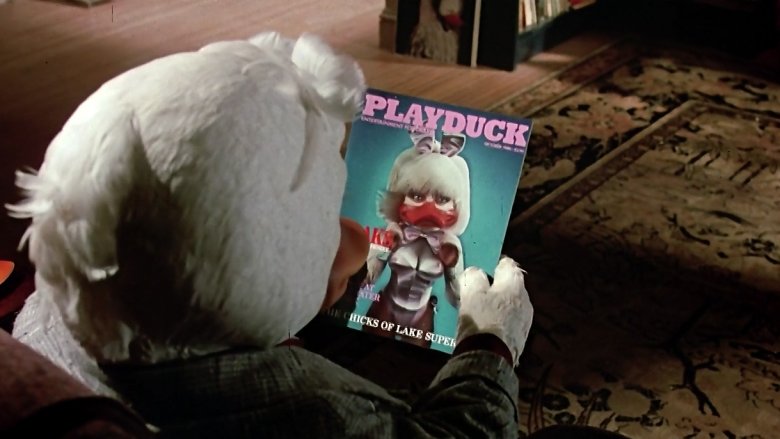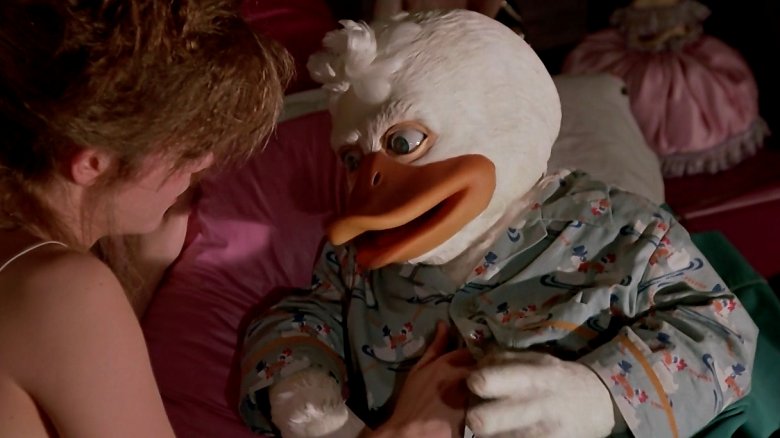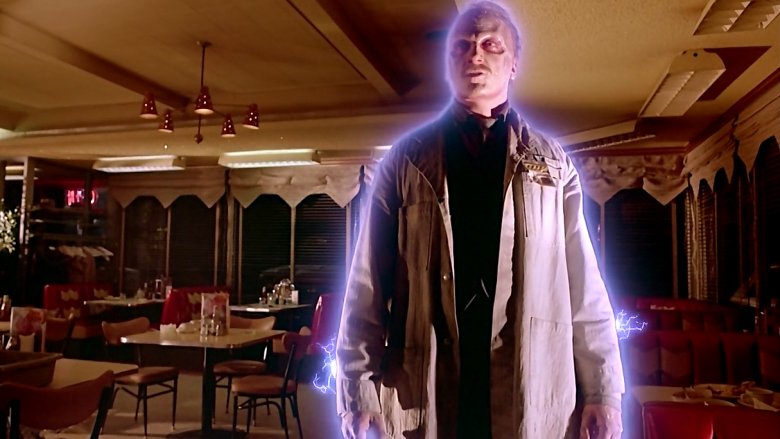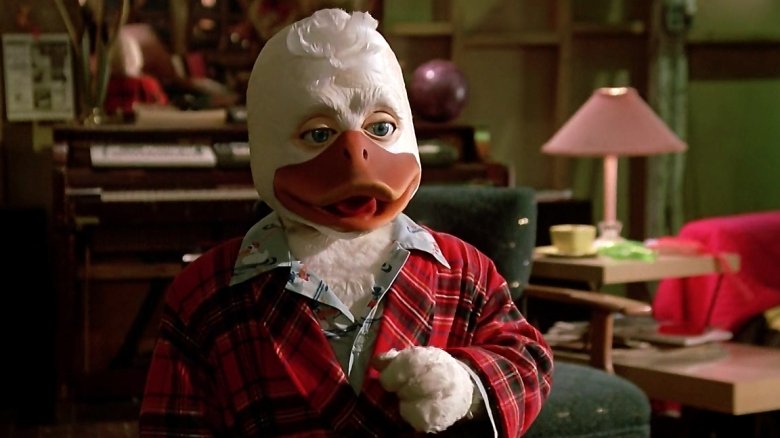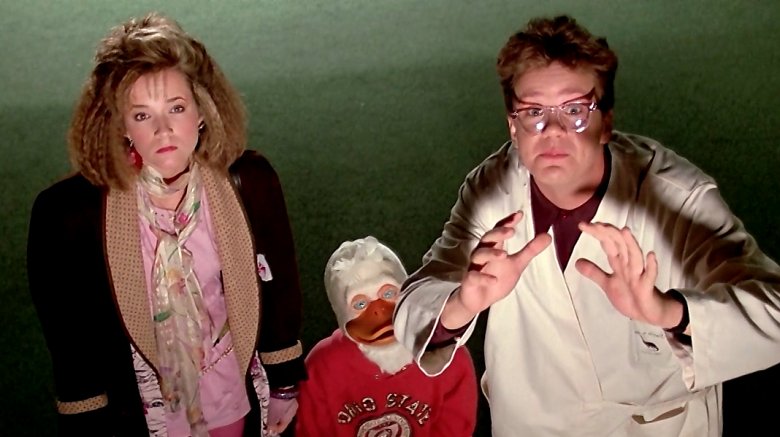The Real Reason Howard The Duck Was A Total Flop
When the Howard the Duck movie arrived in 1986, it had the makings of a surefire hit — it was executive produced by Star Wars mastermind George Lucas, directed by American Graffiti screenwriter Willard Huyck, and written by Huyck and Gloria Katz, whose previous credits included Indiana Jones and the Temple of Doom.
Howard the Duck adapted the Marvel comic of the same name, a cult favorite among readers since being introduced in the 1970s by writer Steve Gerber and artist Val Mayerik. Gerber's groundbreaking writing made the comic's reputation, but the comic remains popular, and some runs are still classics — whereas the movie has gone down in history as one of Hollywood's all-time misfires, currently holding a rating of 15 percent at Rotten Tomatoes. So just what's so bad about Howard the Duck? What went so wrong that a great comic became a terrible film? Let's take a closer look at the real reason the Howard the Duck movie was a total flop.
It should have been animated
As explained in the behind the scenes documentary A Look Back at Howard the Duck (created as a 2009 DVD extra), Huyck and Katz strongly believed that Howard the Duck needed to be animated. After all, it's about a talking duck who wears clothes, and that's very much the traditional domain of animation.
In an animated film, Howard could interact with human characters and both would seem equally real and part of the same world. He could move just as fluidly as anyone else, perhaps even more so since he's a bird who knows "quack fu." However, live action was Lucas' area of expertise, and Universal wanted a live-action blockbuster for summer 1986, so Lucas decided it should be Howard the Duck. With Star Wars under his belt, Lucas figured casting a little person as Howard and using animatronic puppetry to move his face would be no problem. What he didn't take into account is that this would rob Howard of the amount of personality he could have had as a cartoon character — and also make him look like a piece of molded rubber (which he essentially was).
Recapturing the comic
The Howard the Duck comics written by Steve Gerber had an edge. They satirized not just other comics but politics and pop culture of the day. In a sense, they were the mid-1970s comics equivalent to South Park. Gerber was deliberately shaking things up, and that's what made people take notice. Howard even ran for President in 1976, saying "'Why a duck?' you ask? I say why not a duck? You've had turkeys running this country for 200 years!" This was shortly after Watergate, when cynicism about politics — and the presidency in particular — was at a fever pitch.
The movie, however, lacks all that. It's a comedy sci-fi adventure story with no stronger statement than "being different isn't bad." It's missing everything that made the comic popular — probably the same stuff that made Lucas, Huyck, and Katz excited about it in the first place. It's a classic case of all the edges being rounded off a property in the course of adapting it, ruining the whole point of the adaptation.
Personality transplant
The biggest part of that tonal change is in the character of Howard himself. Comic book Howard is sarcastic, often rude, and not necessarily a nice guy. Movie Howard is a very nice guy, constantly. In fact, that's most of his personality. Whereas the sharp edge of comic book Howard gives him a fresh perspective on Earth and America, all movie Howard really has to say is that humans are weird, it's gross and scary that we hunt and eat ducks, and he'd like to go home. Even his relationship with Beverly (about which there's plenty more to say) isn't built on much more than them being nice to each other. There's no spark, no fire, in their interactions or in Howard's personality in general. Basically, he's boring, which the Howard of Marvel Comics never was (at least not in his heyday).
Special effects over story
If you're not going to faithfully adapt Gerber's comics and make a biting satire with something to say about society and the government, then what do you do instead? Well, if you're working with George Lucas, you make a special effects-laden alien invasion story. Instead of a comedic narrative about human (and duck) foibles, you end the film with Howard battling a giant alien with a laser cannon. Obviously, there were always sci-fi elements in Howard's story (he's a sentient duck from another dimension, after all), but the movie is a sci-fi story in a way that the comic never was. This change makes some sense given what George Lucas was known for, but it doesn't serve Howard well.
The derivative script
Another obvious influence on Howard the Duck is Ghostbusters, which was a massive hit two years earlier. Ghostbusters has influenced a lot of films, so it's harder now to see just how unique its structure was at the time. When you really examine it, however, the influence on Howard's plot is clear.
Both films start out as goofy comedies with fantastical elements, like ghosts in the library or talking ducks. As the films build through their second act, the fantastical aspects escalate and become more serious, with the appearance of demon dogs or a huge space laser. By the climax, the heroes are fighting giant demonic monsters who threaten the entire world, be they Gozer or the Dark Overlord. Ghostbusters handles this build expertly, so that each step in the escalation of stakes feels natural. Howard the Duck is much more chaotic, so by the time the Dark Overlord appears, it's not so much that you're ready for it as that you've given up on knowing what to expect from this movie. Also, Howard lacks the wealth of comedic acting talent at its center, which is the real key to Ghostbusters' success.
Who's this for?
Howard the Duck was rated PG and superficially resembles a family film. However, it's filled with adult references, including a duck-sized condom and a scene at the very beginning of the film in which Howard opens a "Playduck" magazine to the centerfold and appears to be about to pleasure himself. Moments after that, as Howard is struck by the laser from Earth and hurtles through the walls of his apartment building, a female duck appears in the bath complete with rather unbirdlike bare breasts and nipples. Throughout the film, things seem a little too grown up for kids without having much to offer adults. Overall, Howard the Duck lacks a real edge, and yet it's not toned down quite enough for a family audience. It's a movie aimed at nobody in particular.
A love that dare not quack its name
Howard's love interest is Beverly Switzler, played by Lea Thompson. Unlike the comic book version, who was a nude model when she first appeared in Howard the Duck #1 and later went to veterinary school, the movie version of Beverly is a rock singer in a band called the Cherry Bombs. Like their comic book counterparts, the movie's Howard and Beverly have a sexual relationship. However, in a live-action movie that lacks the comic's edgy, absurdist tone, a human sleeping with a duck is far more disturbing. Now, to be fair, there's not quite a sex scene — there's there beginning of one, with some light kissing and Beverly in her underwear putting her hand into Howard's pajama shirt. Then they get interrupted. Unfortunately, it's enough. It also makes the conclusion inescapable: When Beverly sings a song about being in love with Howard at the end of the movie, they eventually went all the way offscreen. It's one thing to be an inappropriate for children, but human/duck sex makes most adults uncomfortable as well.
The Dark Overlord
A child watching Howard the Duck might not catch on to what's happening well enough to be disturbed when Howard and Beverly start getting extra friendly. However, they're going to be a lot more disturbed than most adults when Jeffrey Jones' character, scientist Dr. Walter Jenning, transforms into a glowing-eyed, pale-skinned, demonic-voiced monster. When he fully becomes a giant alien at the very end, it's not much worse than something from Star Wars. When the Dark Overlord is still trapped in Jenning's human body, however, he's terrifying — certainly more terrifying than anything that the poster for Howard the Duck would have led you to expect.
The animatronics were a disaster
According to A Look Back at Howard the Duck, the animatronic duck faces never worked as well as they should have. The film had a limited pre-production time, which didn't leave much space to perfect the technology that was meant to bring the star of the movie to life. Some of the duck costumes even exploded or fell apart, and some ducks were built with the wrong proportions for the characters.
As shooting began, the crew was dismayed to discover that the inside of Howard's electronics-filled neck became visible when he opened his mouth. As the effects team improved on the animatronics, Willard Huyck kept having to reshoot Howards scenes. Throughout the movie, he struggled to coordinate his direction through the people on set (including Ed Gale inside the Howard suit) and the puppeteers who controlled Howard's face remotely. Watching the film today, it's particularly glaring how fake Howard — and particularly his facial expressions — look.
The acting isn't all it's quacked up to be
Howard wasn't the only performer in the movie who had a hard time figuring out what to do with his face. Lea Thompson is very charming in Howard the Duck, but she maintains a dreamy quality throughout the movie that makes it hard to figure out if Beverly is meant to be a quirky artist or just kind of out of it. She floats above every scene she's in, particularly when dialogue is involved. By far the worst performance, however, belongs to a young Tim Robbins.
Robbins is a respected actor and has been great in a lot of movies, but he's outright terrible as Phil Blumburtt, a nerdy lab assistant who plays a major role in Howard the Duck. Robbins wildly swings from moment to moment, as if he thinks he's in the cartoon this movie was originally meant to be. At one point he does an embarrassing Donald Duck impression that will make you wonder if this can really be the same actor from The Player and Shawshank Redemption.
It's possible that better performances could have saved Howard the Duck. On the other hand, with its tonal problems, the animatronic issues, failure to target an audience, and the weird sex stuff, it was most likely already doomed for a lot of other reasons. It's a film that just doesn't work, from the decision to make it live action on down. Its reputation as a disaster is not unwarranted, and to the degree that it's fun to rewatch today, the purpose would likely be to make fun of its flaws — a beloved pastime of a certain kind of movie lover.
